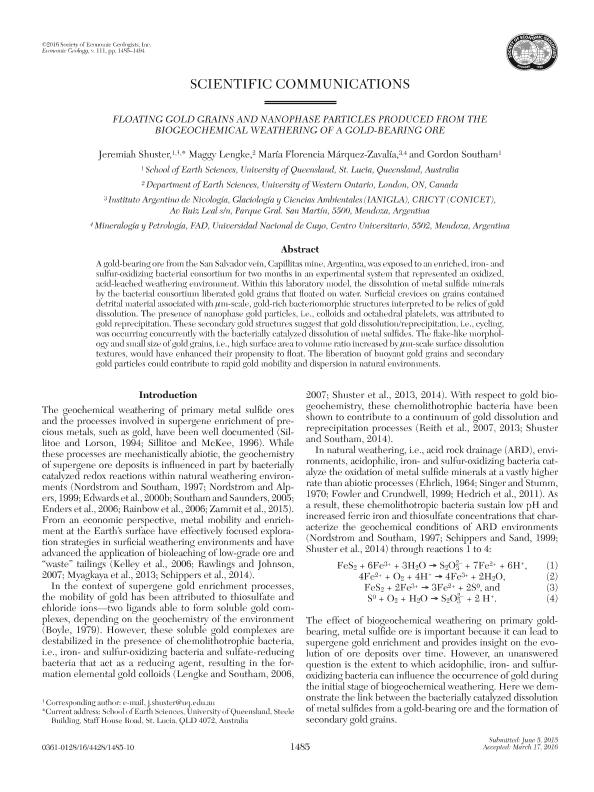Mostrar el registro sencillo del ítem
dc.contributor.author
Shuster, Jeremiah
dc.contributor.author
Lengke, Maggy
dc.contributor.author
Marquez Zavalia, Maria Florencia

dc.contributor.author
Southam, Gordon
dc.date.available
2023-01-03T13:31:10Z
dc.date.issued
2016-10
dc.identifier.citation
Shuster, Jeremiah; Lengke, Maggy; Marquez Zavalia, Maria Florencia; Southam, Gordon; Floating gold grains and nanophase particles produced from the biogeochemical weathering of a gold-bearing ore; Society of Economic Geologists; Economic Geology and the Bulletin of the Society of Economic Geologists; 111; 6; 10-2016; 1485-1494
dc.identifier.issn
0361-0128
dc.identifier.uri
http://hdl.handle.net/11336/183141
dc.description.abstract
A gold-bearing ore from the San Salvador vein, Capillitas mine, Argentina, was exposed to an enriched, iron- and sulfur-oxidizing bacterial consortium for two months in an experimental system that represented an oxidized, acid-leached weathering environment. Within this laboratory model, the dissolution of metal sulfide minerals by the bacterial consortium liberated gold grains that floated on water. Surficial crevices on grains contained detrital material associated with μm-scale, gold-rich bacteriomorphic structures interpreted to be relics of gold dissolution. The presence of nanophase gold particles, i.e., colloids and octahedral platelets, was attributed to gold reprecipitation. These secondary gold structures suggest that gold dissolution/reprecipitation, i.e., cycling, was occurring concurrently with the bacterially catalyzed dissolution of metal sulfides. The flake-like morphology and small size of gold grains, i.e., high surface area to volume ratio increased by μm-scale surface dissolution textures, would have enhanced their propensity to float. The liberation of buoyant gold grains and secondary gold particles could contribute to rapid gold mobility and dispersion in natural environments.
dc.format
application/pdf
dc.language.iso
eng
dc.publisher
Society of Economic Geologists

dc.rights
info:eu-repo/semantics/openAccess
dc.rights.uri
https://creativecommons.org/licenses/by-nc-sa/2.5/ar/
dc.subject
Floating gold grains
dc.subject
Nanophase particles
dc.subject
Biogeochemical weathering
dc.subject
Gold bearing ore
dc.subject.classification
Mineralogía

dc.subject.classification
Ciencias de la Tierra y relacionadas con el Medio Ambiente

dc.subject.classification
CIENCIAS NATURALES Y EXACTAS

dc.title
Floating gold grains and nanophase particles produced from the biogeochemical weathering of a gold-bearing ore
dc.type
info:eu-repo/semantics/article
dc.type
info:ar-repo/semantics/artículo
dc.type
info:eu-repo/semantics/publishedVersion
dc.date.updated
2022-12-27T18:16:22Z
dc.identifier.eissn
1554-0774
dc.journal.volume
111
dc.journal.number
6
dc.journal.pagination
1485-1494
dc.journal.pais
Estados Unidos

dc.journal.ciudad
Colorado
dc.description.fil
Fil: Shuster, Jeremiah. University of Queensland; Australia
dc.description.fil
Fil: Lengke, Maggy. Western University; Canadá
dc.description.fil
Fil: Marquez Zavalia, Maria Florencia. Consejo Nacional de Investigaciones Científicas y Técnicas. Centro Científico Tecnológico Conicet - Mendoza. Instituto Argentino de Nivología, Glaciología y Ciencias Ambientales. Provincia de Mendoza. Instituto Argentino de Nivología, Glaciología y Ciencias Ambientales. Universidad Nacional de Cuyo. Instituto Argentino de Nivología, Glaciología y Ciencias Ambientales; Argentina
dc.description.fil
Fil: Southam, Gordon. University of Queensland; Australia
dc.journal.title
Economic Geology and the Bulletin of the Society of Economic Geologists

dc.relation.alternativeid
info:eu-repo/semantics/altIdentifier/url/https://pubs.geoscienceworld.org/segweb/economicgeology/article/111/6/1485/152499/Floating-Gold-Grains-and-Nanophase-Particles
dc.relation.alternativeid
info:eu-repo/semantics/altIdentifier/doi/https://doi.org/10.2113/econgeo.111.6.1485
Archivos asociados
